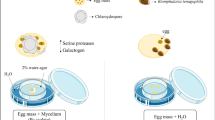Summary
The studies reported show that once a snail has been infected with Paryphostomum segregatum, it becomes completely occupied by the parasite. The small, immature rediae are extremely mobile, going wherever food is available. Mother sporocysts of Schistosoma mansoni developing in the foot, head, or antennae of the snail are an easy prey for small rediae.
Cercarial production in degenerating daughter sporocysts of Schistosoma mansoni steadily diminishes, to be gradually replaced by production of sporocysts.
Zusammenfassung
Die hier beschriebenen Untersuchungen zeigen, daß eine Schnecke, ist sie erst einmal mit Paryphostomum segregatum infiziert, ganz von diesem Parasiten überschwemmt wird. Die kleinen unreifen Redien sind außerordentlich beweglich und wandern überall dahin, wo sie Nahrung finden können. Muttersporocysten von Schistosoma mansoni, die sich im Fuß, im Herzen oder den Antennen der Schnecke entwickeln, sind eine leichte Beute für die kleinen Redien. Die ständig abnehmende Produktion von Cercarien in den degenerierenden Tochtersporocysten von Schistosoma mansoni wird durch die Neubildung von Sporocysten ersetzt.
Similar content being viewed by others
References
Dinnik, J. A., and N. N. Dinnik: The influence of temperature on the succession of redial and cerearial generations of Fasciola gigantica in a snail host. Parasitology 54, 59–65 (1964).
Lie, K. J.: Antagonism of Paryphostomum segregatum redia to Schistosoma mansoni sporocysts in the snail Biomphalaria glabrata. J. Parasit. 53, 969–976 (1967).
—: Further studies on the life history of Echinostoma lindoense Sandground and Bonne, 1940 (Trematode: Echinostomatidae) with a report of its occurrence in Brazil. Proc. helminth. Soc. Wash. 35, 74–77 (1968).
Lie, K. J., and P. F. Basch: The life history of Echinostoma barbosai sp. n. (Trematode: Echinostomatidae) J. Parasit. 52, 1052–1057 (1966).
— The life history of Echinostoma paraensei sp. n. (Trematode: Echinostomatidae) J. Parasit. 53, 1192–1199 (1967).
— D. Heyneman, A. J. Beck, and J. R. Audy: Implications for trematode control of interspecific larval antagonism within snail hosts. Trans. roy. Soc. trop. Med. Hyg. 62, 299–319 (1968).
Author information
Authors and Affiliations
Additional information
Supported by UC ICMRT Grant TW 00144 and AI 07054 NIH, US Public Health Service.
Rights and permissions
About this article
Cite this article
Joe, L.K. Role of immature rediae in antagonism of Paryphostomum segregatum to Schistosoma mansoni and larval development in degenerated sporocysts. Z. F. Parasitenkunde 32, 316–323 (1969). https://doi.org/10.1007/BF00259644
Received:
Issue Date:
DOI: https://doi.org/10.1007/BF00259644




